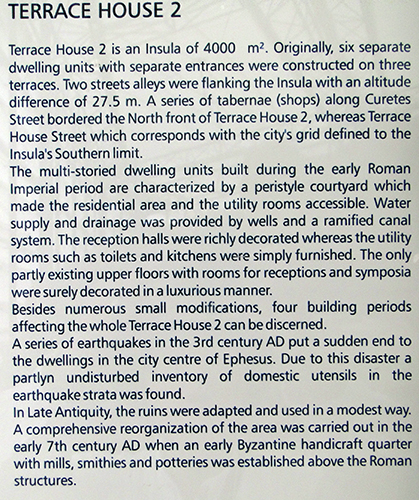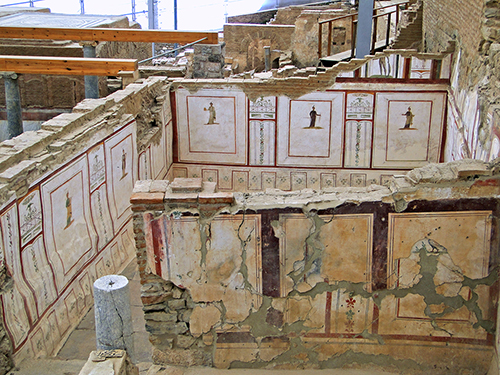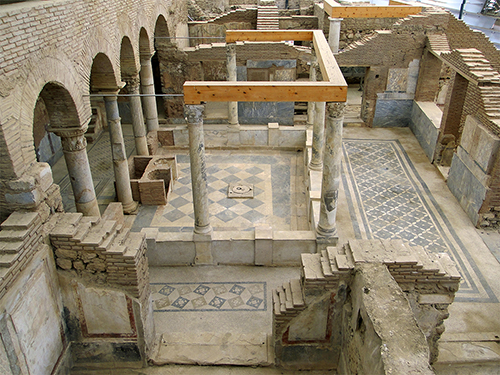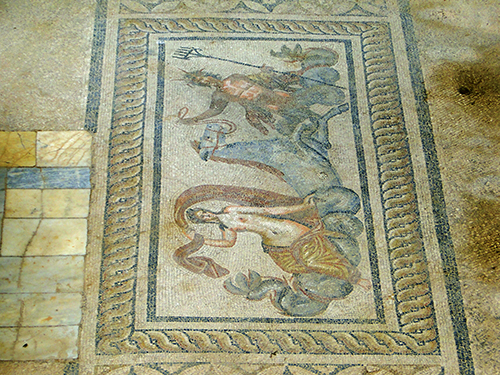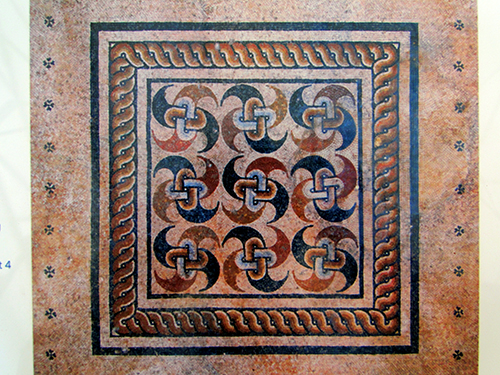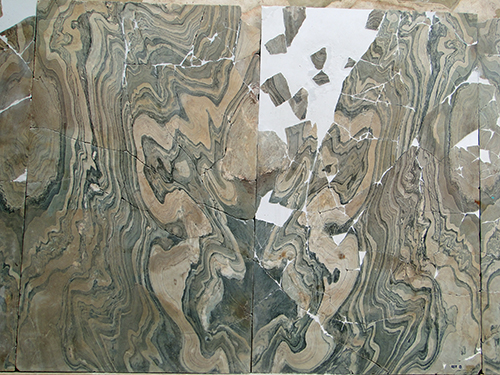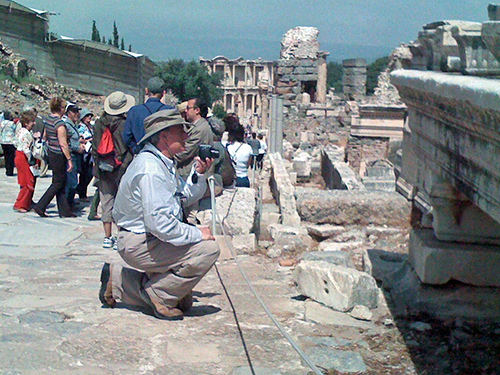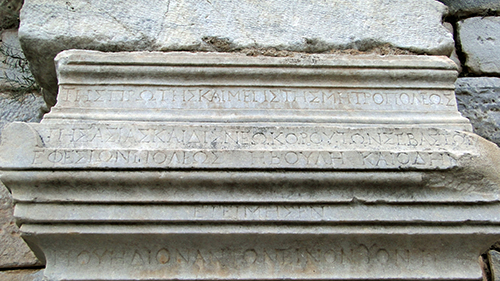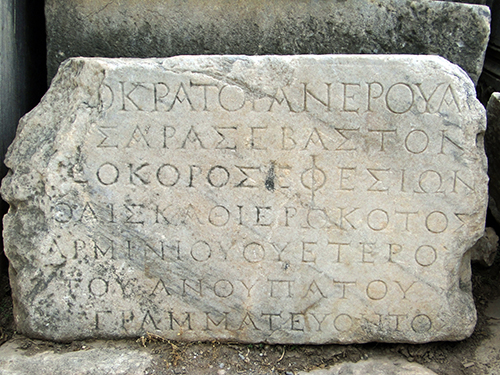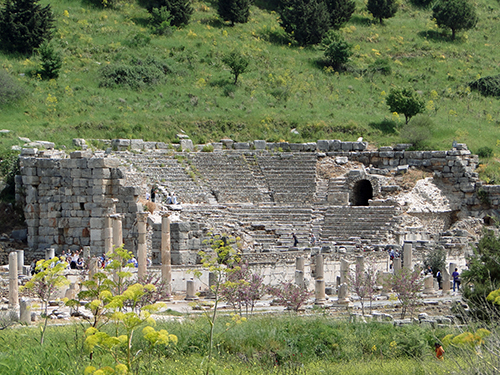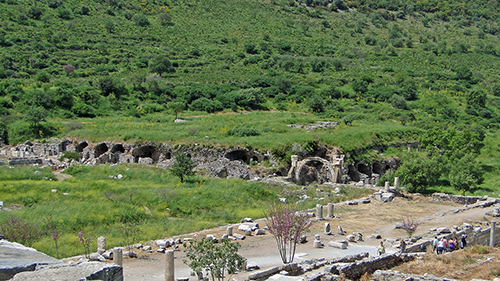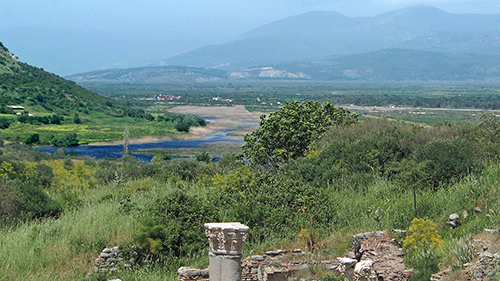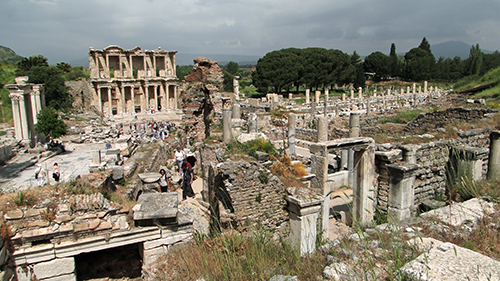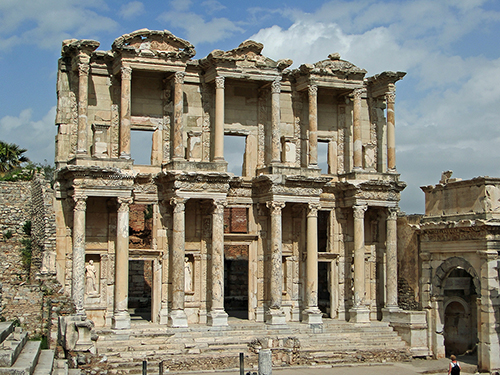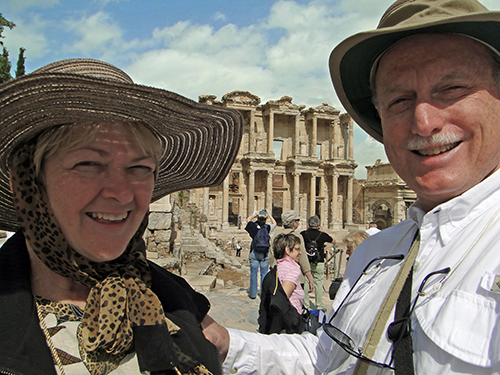April 20, 2010 (Tuesday)
Ephesus. Up early to head to the Ephesus site, just a few kilometers outside the city of Selçuk where we are staying. We have visited ancient Ephesus two other times, both times on our 2002 sabbatical. While touring Turkey in 2002 on our own by car, we made a stop at Ephesus; later, on that same trip, when in Greece we took a cruise excursion from Athens that included a brief stop at Ephesus along the way. Thus, Jerry already had lots of pictures of various attractions at Ephesus, such as the famous theater, the market, the Acadian Way, the Marble Street, Curetes Street, and the Celsus Library. This time around Jerry wanted to catch two main attractions we had not had time for in earlier trips. One was the recently-discovered gladiator burial grounds, which we failed to see this time as well due to Janet Crisler not performing on her promises to Jerry as he was making sabbatical plans. The other attraction was the famous Roman elite terrace homes along Curetes Street, which we were happy to catch this time around.
Terrace Homes. We arrive at ancient Ephesus just as the site is opening. Ephesus is so beautiful, and the Celsus Library at the foot of Curetes Street is as magnificent as ever. More excavations have taken place since we were here 8 years ago. We headed straight for the terrace homes, paid our fee, went inside the covered archeological dig area, and they are stunningly beautiful. Hollywood does not exaggerate the sets of movies in Roman times. The homes are palatial, exquisite! One of the ongoing and very amazing projects is the largest “jig-saw” puzzle in the world—120,000 pieces of marble are being pieced together to put the dining room walls back in their original decoration. The aristocracy of Rome had the best of everything.
The wall frescoes are just beautiful, even in their deteriorated condition. One can imagine the color and striking impression these would make to visitors.
Marble and mosaics are in such abundance that they seem to be treated like common plaster. Geometric designs are quite popular. The colors are nowhere as rich as in the originals. One cannot tell in these images, but a thick layer of excavation dust has settled over every surface, so what you see as “faded” really is not, even many centuries later.
Famous scenes from Greek mythology are a common theme of mosaic art. Below you see Poseidon, god of the sea, riding the waves.
Here is a closeup of the marble being reconstructed from 120,000 pieces back into its original position on the walls of the Marble Hall.
After taking a good while at the terrace homes, we toured the rest of the site, enjoying many of the sights we had seen before. To illustrate my scholar’s tenacious focus on his objectives, even though we have been here twice before, we wound up staying at the Ephesus site for 5-6 hours, practically the whole day. We concluded our visit by doing some shopping for souvenirs, and got some things we like. We ate a sandwich at an outdoor café, and Jerry got some fresh squeezed orange juice, which he loved.
In the inscription below, Ephesus claims the title “first city” of Asia, meaning the most important or the highest honored city with the highest status. One reason for this claim would be receiving from Rome the title of “temple warden” or official representative of the imperial temple in a region.
The inscription below relates to the emperor Nero, whose name appears at the end of the first line in the letters NEPOY. The word before his name is the word autokratora, which means “emperor.”
Columns comprising the entrance of Hadrian’s Gate had been erected since Jerry and I were there in 2002. This gate stands at the bottom of Curetes Street in its juncture with the Marbled Way just in front of the Library of Celsus.
The bouleterion is the chamber council where the elders and leaders of the city met to decide municipal questions on behalf of the city’s welfare. Only the elite with high social status participated in the meetings at the bouleterion. The best shot of this city chamber actually is from far away at the same level of ground standing in the platform area of the temple of Domitian. Jerry used his high zoom to get this shot.
Jerry then hiked all the way across the site and up the hill to the bouleterion to take the second shot below looking back on the platform area of the temple of Domitian while perched on the top wall of the bouleterion (there goes that monkey again). The broad, flat expanse of the temple complex foundation with its supporting arches can be seen in the middle of the picture.
A closeup of the platform support arches of the Domitian temple complex reveals two solitary columns that have been erected by archeologists. The Domitian temple in Ephesus is important evidence not only for emperor worship in the Roman empire in general but for illustrating the popularity and acceptance of the emperor cult throughout the province of Asia. The strength of the emperor cult in Asia is the historical background for the book of Revelation.
Turning the camera westward from another observation area further down Curetes Street reveals the swampy marshland that now surrounds Ephesus and was the reason for her eventual demise. The Mediterranean sea is now several miles away. The ancient harbor of Ephesus was just to the right of where you see the blue marsh water in this picture.
My favorite spot at ancient Ephesus is the Library of Celsus, whose façade is one of the most recognizable tourism pictures of Turkey. In the picture below, the Library of Celsus is in the top left part of the picture. The Gate of Hadrian is visible just to the left of the library façade. The market place where the silversmith riot took place in Acts 19 is to the right of the library. Just in front of the marketplace is the collonaded Marble Street that runs in front of the Ephesian theater (to the right just out of range of the picture).
Akay Hotel Supper. Back to the hotel to record pictures, charge up everything, do email, call mother, etc. We had dinner again on the roof restaurant at the hotel across the street from ours (Akay Hotel) and ran into Nora from the Crisler library, who is so nice; too bad she doesn’t administrate the Crisler programs. We inquired if Janet Crisler ever was able to put together plans to get out of Europe, of which she had been foiled Monday due to the huge air traffic problems over most of Europe created by the recently-erupted Iceland volcano. Nora said Janet had taken a ferry to the island of Samos in hopes of catching a plane to Athens. From Athens she was hoping to catch an overseas flight to the U.S. to try to make her U.S. appointments. Nora loved my Target hat.
Back in our room, we review the maps for tomorrow’s ambitious day trip trying to take in three ancient sites, starting first at the farthest end on the southern coast of Turkey, Didyma, then back up to Milet (Miletus), and then the classical site of Priene, before finally driving all the way back into Selçuk. Whew! Hope we make it!
For a video of the Ephesus action today:
